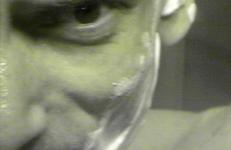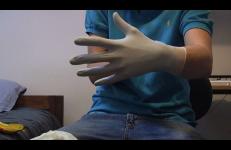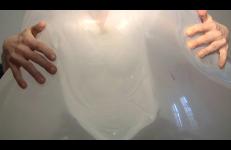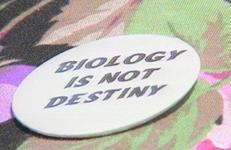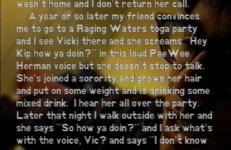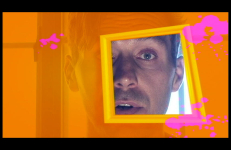An All-American boy and girl are swept into an international intrigue of demonic content as items cursed with the stench of Satan make their way to a museum dedicated to the spiritual overthrow of family values. Loaded with romance, thrills, and exotic adventures, this electronic tele-play, with its colorful moments of scenic horror, leads the viewer on a fast-paced voyage that speeds through the ruins of Egypt, the jungles of equatorial erotica, and the puritanical Wonderland of Middle America.
Sexuality
Told through the voices of three elderly South Carolinian's who reside in the homes in which they were born, Steven Go Get Me A Switch is an oral history mapping dichotomies of gender, familial mythologies, sexuality, and belief. A heavy use of symbolism comingles with suggestions of narrative proof. The desire to be good and the impossibility of such desire becomes a sharp inaudible pitch, like a dog whistles call to violence.
Audacious romanticism displays gardens fueled by the human heart where feelings blossom amid leaf and brick.
Ever listen to Loveline? Well, here's an episode with a 24-year-old Korean American guy who's never been kissed. They're offering free concert tickets to any girl who'll come in and take a chance. The girls get their tickets, and "David" gets to pick one of them for his first smack. Trouble is... no volunteers. Combining personal dating stories and the hypnotic imagery of multi-colored koi, Sweet Or Spicy? explores Hapa and Asian American male sexuality in popular culture.
"I made Take Off in my studio apartment on Myra Avenue during my second year living in Los Angeles. As a member of the Feminist Studio Workshop, I was writing an essay at the time comparing male artists’ representations of their sexuality with female artists’. Vito Acconci was my model for a male perspective. I had been captivated by his videotapes; particularly Undertone, where he was supposed to be masturbating while seated at a table. The videotape was my ultimate response and commentary on Acconci as well as an expression of my own sexuality."
— Susan Mogul
(tell me why): The Epistemology of Disco is an often humorous, at times sarcastic and poignant look at the role that disco music has played in the formation of gay male identity.
People black and blue with life’s bruises, People who glow red with hot passions, or turn deep purple with spiritual purpose are here, boldly rendered in the widescreen format. Sit back and witness the event… See the faces, observe their bodies and hear them speak with their own colors.
In a vile and ingenious way, Acconci pleads with the camera/spectator to join with him, to come to him, promising to be honest and begging, "I need it, you need it, c'mon... look how easy it is." Acconci addresses the viewer as a sexual partner, acting as if no distance existed between them. The monitor becomes an agent of intimate address, presenting a disingenuous intimacy that is one-sided and pure fantasy, much like the popular love songs in the background with which Acconci croons, "I'll be your baby, I'll be your baby tonight, yeah, yeah."
A collage piece. Oppositions of agony and ecstasy are explored. Morticia trims yet another rose stem, while Bugs Bunny takes up Zen. Guilt-wracked, a nun tries furtively to cleans herself of imagined sin. Or attain spiritual release. Various divas flail to no avail. Lips, lipstick, frozen lips. Shakuhachi music by Chris Moran sets the mood, when there isn’t a thunderstorm raging.
A cinematic firestorm of found footage and pilfered Hollywood images, Mike Hoolboom’s hallucinatory Tom – described by the filmmaker as, "Cinema as déjà vu, or déjà voodoo" – pays mesmerizing experimental tribute to the life and work of friend and fellow avant-gardist Tom Chomont, and was selected by a national panel of film critics as one of Canada’s Top Ten of 2002.
The first video of the installation Touch Parade, which as a whole explores “plastic love” or fetish culture and the assimilation of marginalized sexuality on the internet. In questioning what is an explicit and/or illicit image, fetishes found on YouTube that consist of banal gestures, are re-performed. Unlike other pornographic content, these videos evade censoring because they are not culturally recognized as representations of sexuality.
The fourth video of the installation Touch Parade, which as a whole explores “plastic love” or fetish culture and the assimilation of marginalized sexuality on the internet. In questioning what is an explicit and/or illicit image, fetishes found on YouTube that consist of banal gestures, are re-performed. Unlike other pornographic content, these videos evade censoring because they are not culturally recognized as representations of sexuality.
The fifth video of the installation Touch Parade, which as a whole explores “plastic love” or fetish culture and the assimilation of marginalized sexuality on the internet. In questioning what is an explicit and/or illicit image, fetishes found on YouTube that consist of banal gestures, are re-performed. Unlike other pornographic content, these videos evade censoring because they are not culturally recognized as representations of sexuality.
The second video of the installation Touch Parade, which as a whole explores “plastic love” or fetish culture and the assimilation of marginalized sexuality on the internet. In questioning what is an explicit and/or illicit image, fetishes found on YouTube that consist of banal gestures, are re-performed. Unlike other pornographic content, these videos evade censoring because they are not culturally recognized as representations of sexuality.
The third video of the installation Touch Parade, which as a whole explores “plastic love” or fetish culture and the assimilation of marginalized sexuality on the internet. In questioning what is an explicit and/or illicit image, fetishes found on YouTube that consist of banal gestures, are re-performed. Unlike other pornographic content, these videos evade censoring because they are not culturally recognized as representations of sexuality.
Transexual Menace takes its title from the name of "the most exciting political action group in the USA"—transgendered people who are defining themselves, demanding their legal rights, and fighting for medical care and against job discrimination. Considered by von Praunheim to be the “most fascinating [project] in my long life as a filmmaker,” Transexual Menace is a sensitive and carefully crafted portrait that deals with issues openly and honestly. “I was able to earn the trust of many who are often reluctant to be interviewed.
Uh-Oh! is a love story that revolves around the classic text, The Story of O. Not an adaptation, but rather a critical analysis of masochism that investigates the relationship between love, risk-taking, spirituality, power, and sex. An all-female cast plays cowboys who stage sado-masochistic rituals in the basement of a diner. A waitress named Oh (Emanuela Villorini) falls in love with a cowboy (New York poet Eileen Myles).
This feature-length experimental narrative, about women’s relationships to new reproduction technologies and genetic engineering, combines documentary interviews with field experts and a science fiction segment depicting stories of in-vitro fertilization and other methods. Underexposed: The Temple Of The Fetus examines ways the news media shapes perceptions and social attitudes towards medical topics.
In this now infamous tape, exemplary of his early transgressive performance style, Acconci sits and relates a masturbatory fantasy about a girl rubbing his legs under the table. Carrying on a rambling dialogue that shifts back and forth between the camera/spectator and himself, Acconci sexualizes the implicit contract between performer and viewer—the viewer serving as a voyeur who makes the performance possible by watching and completing the scene, believing the fantasy.
This title is only available on Kip Fulbeck Selected Videos: Volume Two.
Two guys with their heads in the clouds and their feet in the mud of the world, can not be Angels until their earthbound urges are tamed. Despite the overwhelming odds against this, the handsome, hot blooded boys are determined to earn their 'halos' and win their heavenly 'wings'.
This video was originally part of an installation at the Whitney Museum of American Art, part of which included the video collaboration Channels of Desire. Recreating coin-operated porno booths, Channels aired one photo image on seven TVs, interrupted only by the viewer inserting a coin and choosing a segment. The concept behind it was the construction of desire in categorical ways, the form of the piece speaking to sexual desire as something that is constantly evading the viewer. The images presented women’s experiences with interracial, lesbian, and heterosexual encounters.
Made for Madrid Pride 2017, Wonders Wander is a location based mobi-web-serial with four fictional episodes set in Madrid.
Ming Wong creates videos that explore performance and issues of race and gender. Born in Singapore of Chinese heritage, and now based in Berlin, his work examines cross-cultural experiences by appropriating scenes of iconic world cinema. Wong casts himself anachronistically as the star, critically exposing the otherness of the relationship of media and world history.
In 1939, Westinghouse made a film about a small-town family visiting the New York World's Fair. Trapped inside that film was a completely different film that shows a mysterious alternate universe, revealed by Bryan Boyce’s own patented brand of narrative deconstruction and evisceration.The outcome is an absurd and chilling drama of a family transfixed by the technological wonders that would soon transform consumer society.













